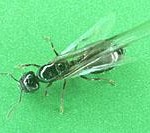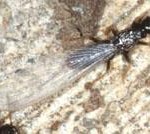Minnesota Ant Pest Control
Ants are social insects that belong to the same order as the wasps and bees that live together in cooperative, intermingling colonies. The colonies may range in size from hundreds to millions of individuals, depending on the species. Within each colony are different types of individuals, each with a specific function.
All ant colonies contain one or more queens, whose primary role is to lay eggs. The eggs hatch into white, grub-like larvae that later transform into adult “worker” ants. The workers feed and care for the queens and developing brood, and are the ones seen foraging for food and water, often at great distances from the colony. Ants lay down invisible odor trails, which the workers follow between food and the nest. In many species, the trail of ants is distinct enough to be followed back to the nesting location, or to where the ants are entering from outdoors.
At certain times of the year, ant colonies produce large numbers of winged individuals known as swarmers. These winged ants emerge from the nest to mate and establish new colonies. When a swarm of ants emerges inside a home, it’s an indication that a nest is present within the structure. Fortunately, the success rate for swarmers establishing new colonies inside buildings is low. Nonetheless, a bunch of winged ants emerging indoors can be disturbing and often mistaken for termites.
Distinguishing features of ants and termites
Appearance of winged ant (left) versus winged termite (right). Note the pinched waist and elbowed antennae on the ant.
Winged ants can be distinguished from termites by comparing certain features. Ants have a narrow (pinched) waist similar to wasps, whereas termites are virtually the same width from end to end. Ants and termites each have four wings; however, on ants the front wings are longer than the hind wings while on termites all four wings are of equal size and length. Finally, the antennae of ants are bent or “elbowed” whereas termite antennae are straight.
Ants build their nests in many different locations both inside and outside of buildings. Species nesting inside, or foraging indoors for food or moisture, tend to be the most challenging to control.
The mistake most people make when attempting to control ants is only spraying the ones they see. This approach usually fails because the ants seen foraging over exposed surfaces is only a small portion of the colony. Typically, there will be thousands of additional ants including one or more egg-laying queens hidden somewhere in a nest. Eliminating queens and other colony members within nests is often the key to effective ant control.
Dealing with ants can be very frustrating. To most homeowners, all ants look pretty much alike. In truth, dozens of different species occur around homes and buildings, each having unique characteristics which may influence the method of control.
Ant identification is can be critical to solving the ant infestation. By identifying the ant, you better understand ant nesting sources, the size of the ant colony and what chemical and non-chemical treatments will best solve the ant problem.
The most important thing to remember about ant colonies is that they have multiple satellite nests. This means that even if you think you’ve found the source of your problems, the untrained eye will may not be able to spot and exterminate all the actual nests on your property.
Do-It-Yourself methods of ant control are not often successful. Many over-the-counter pesticide products for consumer purchase are not an adequate means to control ant colonies because they are not customized or suited to treat the particular species of ant you are having a problem with.
A Minnesota Pest Control Expert will be able to tell the difference in ant species. They are also trained to seek out foraging ant trails around your property, in an effort to locate and terminate the entire colony.





